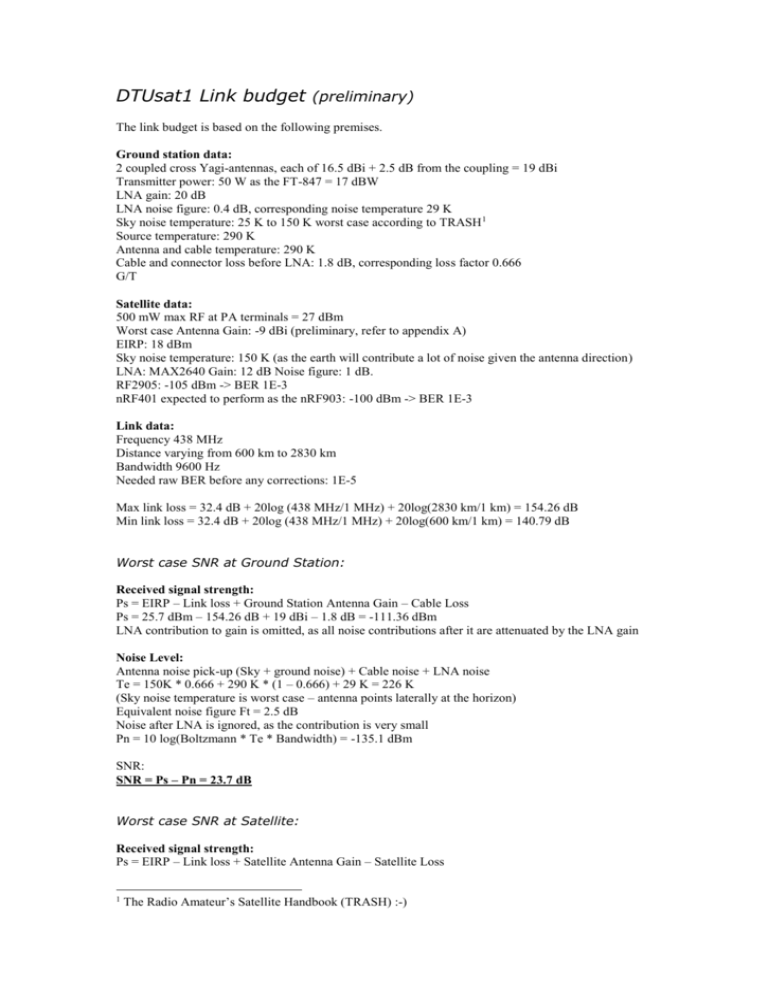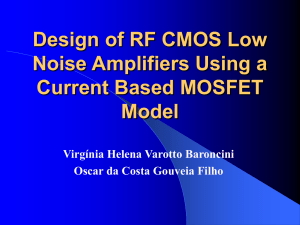DTUSat - COM - Link Budget
advertisement

DTUsat1 Link budget (preliminary) The link budget is based on the following premises. Ground station data: 2 coupled cross Yagi-antennas, each of 16.5 dBi + 2.5 dB from the coupling = 19 dBi Transmitter power: 50 W as the FT-847 = 17 dBW LNA gain: 20 dB LNA noise figure: 0.4 dB, corresponding noise temperature 29 K Sky noise temperature: 25 K to 150 K worst case according to TRASH 1 Source temperature: 290 K Antenna and cable temperature: 290 K Cable and connector loss before LNA: 1.8 dB, corresponding loss factor 0.666 G/T Satellite data: 500 mW max RF at PA terminals = 27 dBm Worst case Antenna Gain: -9 dBi (preliminary, refer to appendix A) EIRP: 18 dBm Sky noise temperature: 150 K (as the earth will contribute a lot of noise given the antenna direction) LNA: MAX2640 Gain: 12 dB Noise figure: 1 dB. RF2905: -105 dBm -> BER 1E-3 nRF401 expected to perform as the nRF903: -100 dBm -> BER 1E-3 Link data: Frequency 438 MHz Distance varying from 600 km to 2830 km Bandwidth 9600 Hz Needed raw BER before any corrections: 1E-5 Max link loss = 32.4 dB + 20log (438 MHz/1 MHz) + 20log(2830 km/1 km) = 154.26 dB Min link loss = 32.4 dB + 20log (438 MHz/1 MHz) + 20log(600 km/1 km) = 140.79 dB Worst case SNR at Ground Station: Received signal strength: Ps = EIRP – Link loss + Ground Station Antenna Gain – Cable Loss Ps = 25.7 dBm – 154.26 dB + 19 dBi – 1.8 dB = -111.36 dBm LNA contribution to gain is omitted, as all noise contributions after it are attenuated by the LNA gain Noise Level: Antenna noise pick-up (Sky + ground noise) + Cable noise + LNA noise Te = 150K * 0.666 + 290 K * (1 – 0.666) + 29 K = 226 K (Sky noise temperature is worst case – antenna points laterally at the horizon) Equivalent noise figure Ft = 2.5 dB Noise after LNA is ignored, as the contribution is very small Pn = 10 log(Boltzmann * Te * Bandwidth) = -135.1 dBm SNR: SNR = Ps – Pn = 23.7 dB Worst case SNR at Satellite: Received signal strength: Ps = EIRP – Link loss + Satellite Antenna Gain – Satellite Loss 1 The Radio Amateur’s Satellite Handbook (TRASH) :-) Ps = (47 dBm – 4.4 dB + 19 dBi) – 154.26 dB + 0dB – 2 dB = -94.66 dBm The Ground station cable loss is calculated using 15 m standard RG58 cable2 as the ground station will be situated at the top floor in building 348. The actual cable used might be better. The Satellite Loss is calculated from the transmission coefficient of the antenna, (-1.2 dB) and miscellaneous other losses. Noise Level: Antenna noise pick-up + Cable noise + RF2905 noise Te = 150K + 353 K * (1 – 0.630) + 2610 K = 2890 K Sky noise temperature is high, as the antenna is looking at the earth Satellite temperature is worst case (80°C) Satellite transceiver equivalent noise figure Ft = 10 dB according to data sheet for RF2905 Pn = 10 log(Boltzmann * Te * Bandwidth) Pn = 10 log (K*Te*B) = -124.2 dBm SNR: SNR = Ps – Pn = 29.6 dB Conclusions: The received signal strength is within the operating limits of the transceivers we are considering, but it is very close to the limits (-100 dBm for both chips). We recommend that the ground station PA is upgraded to ensure reliable operation. Alternatively – and maybe better – the satellite can be equipped with an LNA, which are available as single chips solutions at Maxim. Using their MAX2640, we gain about 12 dB signal and reduce the noise, as the transceiver noise figure is reduced by the gain while adding only 1 dB noise figure from the LNA. The Signal to Noise ratios will give us very good reliability. According to this chart 3, we will not expect any bit errors at all under normal operating condition. If errors occur, they will be detected by the protocol and the packet affected will be resent, but error-correcting codes are probably not necessary. The method used above is taken from The Radio Amateur’s Satellite Handbook, page 8-12 2 3 http://www.timesmicrowave.com/cgi-bin/calculate http://home.netcom.com/~chip.f/viterbi/simrslts.html Below is a preliminary draft of the link budget using Flemming Hansen’s magic link budget equation from the communication presentation. Eb N 0 EIRP G T 196.15 20 log( d f B ) 20 log( ) 10 log( )[ dB] 1km 1MHz 1Hz Satellite to Ground Station Eb/N0 = EIRP + G/T + 196.15 – 20 log (438 MHz/ 1MHz) – 20 log (2830 km/1 km) – 10 log (9600) = –3 dBW – 8 dB/K + 196.15 – 52.83 – 69.04 – 39.82 = 23.46 dB -> No error correction needed. G/T : – 8 dB/K arbitrarily chosen Ground Station to Satellite Eb/N0 = EIRP + G/T + 196.15 – 20 log (438 MHz/ 1MHz) – 20 log (2830 km/1 km) – 10 log (9600) = 17 dBW + 19 dBi – 20 dB/K + 196.15 – 161.69 = 50.46 dB -> No error correction needed. G/T : – 20 dB/K arbitrarily chosen Vi har et problem med at få identificeret størrelsen af G/T, hvilke jo er rimeligt vigtigt. Tallene ser også særdeles optimistiske ud – hvordan kan det være? Vi er heller ikke helt sikre på at det er det samme vi regner ud – båndbredden indgår på samme måde i begge regnestykker, men G/T skal indeholde temmelig meget information for at få regnestykket til at gå op.






